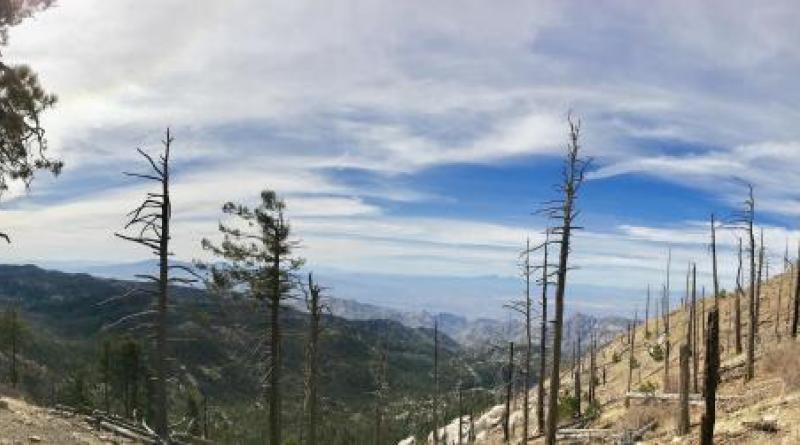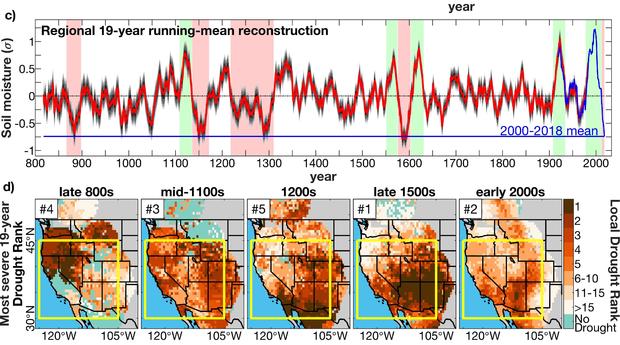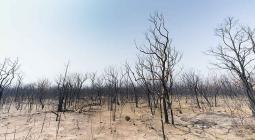Megadrought emerging in western U.S. could be the worst in 1,200 years, study finds.

Catastrophic wildfires, decreasing snowpack and dwindling water resources have become a normal part of life for residents in the western U.S. And, as a result of climate change, this may be just the beginning. A new study from Columbia University says the region has now entered into a climate-driven megadrought — possibly the worst in modern history.
Since 2000, the West has experienced one of its driest 20-year periods in history due to a combination of a dry natural cycle and the changing climate. While there have been some wet years like in 2019, overall water resources have been under unprecedented stress in the modern era.
Going back over a thousand years, there's evidence that naturally driven megadroughts have devastated the region several times in history. These droughts led to upheavals among indigenous civilizations in the Southwest.
Scientists have long suspected that the current situation has been evolving into one of these megadroughts. This new research, published in the journal Science, not only confirms that suspicion, but also concludes this megadrought is as bad or worse than anything known before.
To reach this conclusion, the team conducted what they call the "most up-to-date and comprehensive long-term analysis" covering an area stretching across nine U.S. states from Oregon and Montana down through California, New Mexico and part of northern Mexico.
Their analysis utilized 1,200 years of tree ring data, modern weather observations and dozens of climate models. While reliable modern observations only date back to about 1900, yearly growth of tree-rings allows scientists to gauge annual changes in soil moisture centuries in the past.
"We now have enough observations of current drought and tree-ring records of past drought to say that we're on the same trajectory as the worst prehistoric droughts," says lead author Park Williams, a research professor in the Lamont-Doherty Earth Observatory at Columbia University.
Using the tree-ring data, Williams and his team detected dozens of droughts across the region, starting in 800 AD. Four of those stand out as megadroughts — with extreme dryness which lasted for decades — in the late 800s, mid-1100s, the 1200s and the late 1500s.
The team then compared the ancient megadroughts to soil moisture records from the years 2000 to 2018. As illustrated in the below image, they found that this 19-year period was the second-driest, already outdoing the three earliest ones and on par with the fourth period which spanned from 1575 to 1603. The other megadroughts lasted longer, which is why their red shading is wider, but they all began on a similar path to this modern drought.

What separates this drought from past megadroughts is that the natural dry cycle is magnified by a warming climate. This has caused the modern megadrought to impact an even wider area than any of the past ones.
Climate change has boosted temperatures in this part of the West upward by 2.2 degrees Fahrenheit in the past 20 years. Since warmer air holds more moisture, extra moisture is increasingly being drawn from the ground, intensifying drying soils.
The researchers say rising temperatures due to human-caused climate change are responsible for about half the pace and severity of the current drought. Since regional temperatures in the West are projected to keep rising, this trend is likely to continue.
"Because the background is getting warmer, the dice are increasingly loaded toward longer and more severe droughts," said Williams.
Another interesting finding in the research: The 20th century was the wettest century in the entire 1,200-year record. So the conditions we may think of as "normal" were actually a historical fluke.
"The 20th century gave us an overly optimistic view of how much water is potentially available," said co-author Benjamin Cook.
This is problematic for water resource managers, especially with an exploding population. Because the past century was not representative of typical water availability, and climate change is stripping away water at an ever increasing rate, policy makers and managers have been forced to grapple with the new climate reality.
Jeff Lukas, with the Western Water Assessment at University of Colorado, has noticed an increasing consensus in the past decade within the water management community about the urgency of the task. "The rethinking began with their approaches to long-term planning, which now increasingly incorporate climate change," said Lukas.
This urgency is motivated by a strain on once abundant water resources. The mighty reservoirs of Lake Mead and Lake Powell along the Colorado River, which supply water to agriculture around the region, have shrunk dramatically. In addition, insect outbreaks are ravaging dried-out forests, making them more vulnerable and generating fuel for wildfires.
Lukas says although water availability has been an issue, so far urban water supplies have been pretty resilient and managers have done a good job at reducing per-capita water use. "The biggest impact to everyday people from the changing climate and inevitable future megadroughts is not — perhaps surprisingly — towns and cities running out of water," explains Lukas.
Instead, he is more concerned about out-of-control blazes.
"I think the biggest impact is the West-wide increase in very large and intense wildfires, which will get even worse in a warmer future and perhaps unimaginable during a future megadrought."
Lukas says that while water managers are pragmatically oriented to consider the risks presented by climate change, their biggest challenge is gaining cooperation.
"Climate change plays out on much longer time scales than electoral cycles, and climate change has become a highly partisan and divisive topic in this country," he said.
And while recently there have been some changes in specific policies and management decisions to adapt, Lukas says significant obstacles remain. "When managers need the backing of elected officials and the public to pursue and enact policies motivated by the new climate reality, they can be constrained by short-term thinking and partisan opposition."
*Watch the video here
16 April 2020
CBS NEWS




